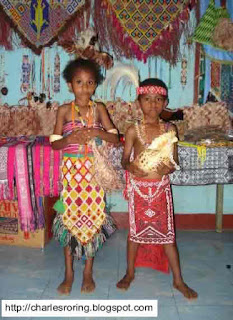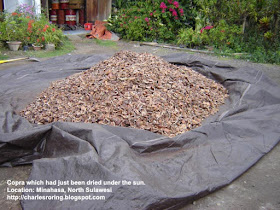 |
| Lucky Kaikatui and his family |
From the porch to the living room and the kitchen, a lot of paintings depicting the beauty of Papua's nature and culture decorate the walls. Nearly no more rooms left for him to put new paintings that he creates every week.
Lucky Kaikatui is a prolific painter. Ironically, art lovers in Indonesia do not know him. He lives in Manokwari, a small town in the northern coast of West Papua far from Jakarta (the capital of the state) and unnoticed by Indonesian mass media.
The character of this painter is very strong. This can be seen from the lines that he brushes on canvas. They are strong and full of meanings. His schoolmates have called him a brilliant illustrator since he was in the first grade of elementary school of SD Negeri I Manokwari. When the Dutch were still in Manokwari, this school was called Klim en Daal. His first drawing, entitled "Pendekar Si Kapak Hilang" (The warrior of the missing axe), was snatched away by his friends.
In junior high, Lucky's paintings decorated the library room of his school. After completing his study in junior high, Lucky moved to Jayapura to carry on to high school. Again, in that city, he attracted people's attention with his paintings. In 1985, he participated in a painting competition of West Papua province for high school and general levels. For high school level he was the best whereas for the general one he won the second winner. His natural talent draw the attention of the officials from Irian Jaya's Department of Education and Culture. As the result in 1986, although he was still in High School, he could organize three painting exhibitions in Jayapura. In every exhibition, he displayed at least 30 paintings. The young Lucky Kaikatui finished his high school study in 1987. He tried to enroll in ISI (Indonesian Institute of Art) in Yogyakarta, a city in Central Java Indonesia. Unfortunately he could not realize his ambition because his parents did not have enough money to support his study in Java island.
Realizing his family economic condition, Lucky then returned to Manokwari and joined an entrance test for becoming a civil servant. He passed the test and was received as a civil servant in Manokwari regency. At the time he was sent to a remote post in Anggi, a small village in the highlands of Arfak mountains. The climate of Anggi is very cold. The village is surrounded by "virgin" forest and two lakes. It is isolated from outside world. There is no asphalt road connecting Anggi to the capital town, Manokwari. He had to work in that post and was not allowed to go to the town. The limitation did not discourage him from working for the villagers with his whole heart. According to Lucky, besides working for these villagers, he got the chance to experience in full the natural beauty of Papuan's culture and nature in their purest condition. They would become abundant inspirational resources for his later works.
Although he had been working as a civil servant, he never gave up his ambition to study in higher institution. Patiently he saved his salary for that purpose.
After working for three years and never returning to Manokwari, suddenly he fell ill with Malaria and had to go to Manokwari. While suffering, Lucky decided to leave for the town. He had to walk through the Arfak mountains with its tropical rainforest for three days. Lucky was accompanied by some Arfakkers who were also going to Manokwari. Later he poured these three days walking experiences on canvas. One of them is "Penetrating isolation for a drop of life." This painting describes the natural challenge which the Papuan have to face when they want to go to town only for buying their daily basic needs such as salt, sugar, and cooking oil. Besides there is no asphalt road, there are a lot of small and big rivers between Anggi in Arfak mountains and Manokwari. The villagers must walk on the falling trees to cross big rivers.
Back in town he went to the regent of Manokwari, Mr. Drs. Esau Sesa, to report about the villagers' problems in the form of a painting. The regent accept it and was impressed by his work saying, "a very talented painter like you should be given a chance to further your study and develop your works as an appreciation for Papuan art and culture." Within a short time after the meeting, he got the regent's permission to continue his study in Java island. This time his leaving for Java was a tour of duty financed by the local government.
Based on the directions from local government officials, he was told to take cinematography as his study program in Institute Kesenian Jakarta – IKJ (Jakarta's Institute of Fine Art). It was against his will actually. So, although he was registered as student of cinematography, he could always be seen in the painting department. It was not surprising that finally the painting department of IKJ received him on semester IV as its student.
During his study in IKJ, Lucky and his schoolmates got opportunities to carry out comparative study in ISI Jogja, his dreamed school when he was still in high school. From Jogja, he continued to Ubud, Bali. There, he studied for one month under the supervision of Prof. Srihadi. In Bali, Lucky studied the works of Anthony Blanco, Arie Smith, Eisnel, and I Nyoman Made Lempar.
He had been going around in Java and Bali for eight years when suddenly he was called to return to West Papua. His mother was ill waiting for him to accompany her in her last moments.
Upon returning to Manokwari, Lucky and his friends set up PUMA – Perupa Manokwari (Artists of Manokwari). It is an association of Manokwari's artists. The organization is established to promote Papuan culture to outer world.
He also passes on his painting skills to other young Papuans who are interested in painting and want to become artists. Now he is teaching them at his home. Some of them are Yabal Marbuan, Alberth Marbuan, Alberth Warijo, Carlos, Septinus, and Mesakh. Some are still studying at junior and high schools whereas the others are drop-outs. He hopes that these young Papuans, with other senior artists, can fight together to preserve Papuan cultural identity which is now facing degradation due to modernization, and globalization.
For Lucky Kaikatui, painting is a struggle. He has always reminded Papuan youth not to forget and leave their cultural identity. It is one of the most important West Papuan assets which has to be passed on to the next West Papuan generations. Every painting Lucky makes has a unique background story. For instance, "ALive or Death," this painting depicts a tense moment between Cassowary and the hunter. Lucky's grandfather was an experienced and famous Cassowary hunter in their village. According to his grandfather's story, if the spear missed its target, the hunter may die stabbed by its three sharp claws.
There is also another painting entitled Doreri Bay Manokwari. The background of the painting is Arfak mountains. The traditional sail of the boat is made of woven pandanus leafs, the same material for making Papuan mat. Now, there are not any sail that use the leaves. Most of the boats now are driven by plastic sheet sail or outboard engines. For most Papuans, Mansinam island of Manokwari is a familiar name in their ears. The preaching of gospel in Papua was started in this island. Every year, on fifth February, tens of thousands of West Papuans gather in Mansinam island to commemorate the landing of Otto and Geisler, two Europeans who were the first evangelists to spread the Christianity in Papua.
In the world of Indonesian fine art, he is not recognized. Lucky Kaikatui lives in a small town Manokwari far from the coverage of Indonesian mass media which are mostly located in Java. His painting exhibitions both in Manokwari and Jayapura do not get enough publicity. That's why art communities never heard of him.
This condition does not discourage him. He keeps on painting. New paintings are created every week. To minimize the cost, he makes the canvas by himself. He had mastered the techniques when he was still an IKJ's student. His wife, Rahab, always supports him. The Kaikatuis live in a house in Kompleks Missi of Brawijaya street, Manokwari, West Papua.
If you are interested in Lucky's paintings, you can visit him in Manokwari town. Please, contact me by email to peace4wp@gmail.com before you come.
Minahasa is one of the regencies in Indonesia that has large area of coconut plantation. Coconut has been an important export commodity of the Province of North Sulawesi. After harvesting the fruit, farmers take the white flesh out of the shells and dry it under the sun or roasted it using the shells as the burning fuel. A fresh white flesh or endosperm contains around 40% oil while the dried one, called copra, contains up to 65% oil. Usually, farmers sell their copra to Bimoli factory in Bitung municipality. One metric ton of copra needs between 9,000 and 11,000 coconut fruits.




 While I was walking around Sonder village, in Minahasa, the Province of North Sulawesi, I saw many kinds of flowers. One of them is Canna. Varieties of Canna have bright colours such as red, yellow, pink, and white. These flower plants are grown in the front yard of most of the villagers houses.
While I was walking around Sonder village, in Minahasa, the Province of North Sulawesi, I saw many kinds of flowers. One of them is Canna. Varieties of Canna have bright colours such as red, yellow, pink, and white. These flower plants are grown in the front yard of most of the villagers houses.

















